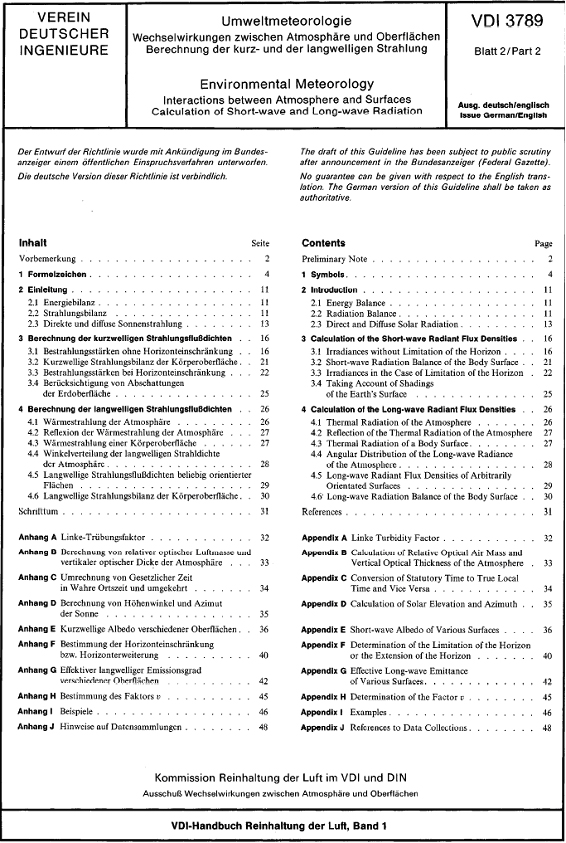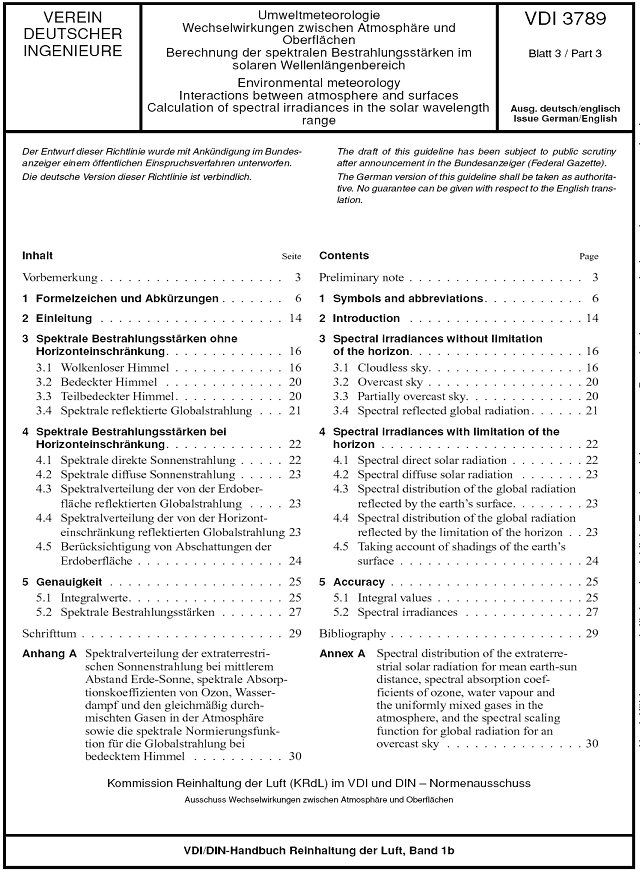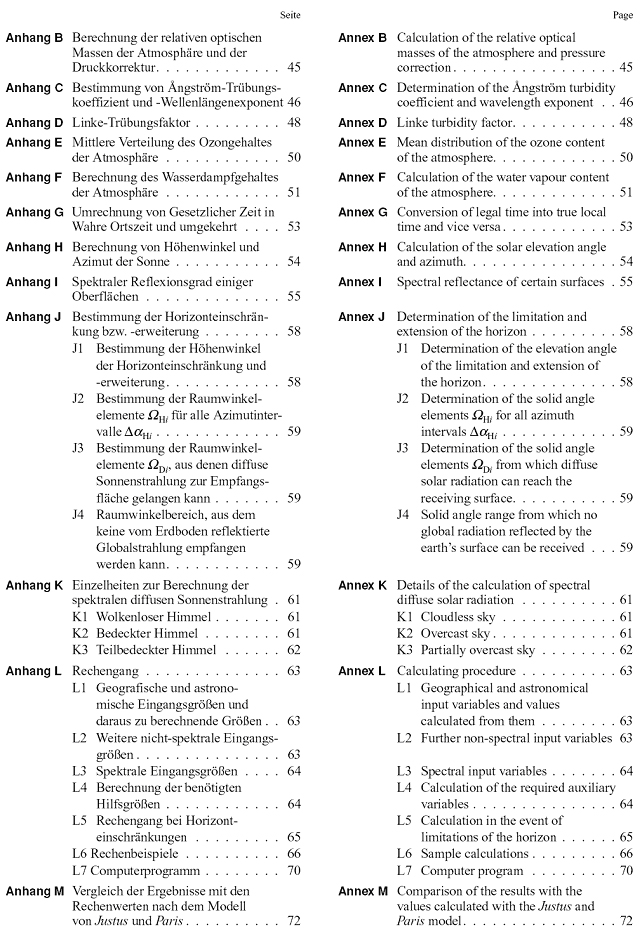ALBEDO TERRESTRE -
ELENCO NORME
ASTM Standards
- E 1980-01: “Standard Practice for Calculating Solar
Reflectance Index of Horizontal and Low-Sloped Opaque Surfaces”.
This practice covers the calculation of the Solar Reflectance Index (SRI) of horizontal and low-sloped opaque surfaces at standard conditions. The method is intended to calculate SRI for surfaces with emissivity greater than 0.1.
- E 1918-06: “Standard Test Method for Measuring Solar
Reflectance of Horizontal and Low-Sloped Surfaces in the Field”.
This test method covers the measurement of solar reflectance of various horizontal and low-sloped surfaces and materials in the field, using a pyranometer. The test method is intended for use when the sun angle to the normal from a surface is less than 45.
- C 1483-04: “Standard Specification for Exterior Solar
Radiation Control Coatings on Buildings”.
The purpose of this specification is to provide general requirements for products used to reduce thermal loads on buildings by reflecting solar radiation from roofs and walls. Radiation control coating (RCC) is a liquid applied coating having a solar reflectance of 0.8 and an ambient temperature total hemispherical emittance of at least .08.
This specification covers the physical and mechanical properties of liquid-applied radiation control coatings (RCCs) designed for exterior application on buildings or other structures, where ambient air temperatures range form -34 to 54oC (-30 to 130oF). The specification also includes the testing procedures by which the acceptability of the material may be determined.
The products that comply with this specification may be used for other applications and have other properties not covered by this specification. In such cases, it is advisable to check other specifications that address the applications of interest.
- G 173-03e1: “Standard Tables for Reference Solar Spectral
Irradiances: Direct Normal and Hemispherical on 37° Tilted Surface”.
These tables contain terrestrial solar spectral irradiance distributions for use in terrestrial applications that require a standard reference spectral irradiance for hemispherical solar irradiance (consisting of both direct and diffuse components) incident on a sun-facing, 37° tilted surface or the direct normal spectral irradiance. The data contained in these tables reflect reference spectra with uniform wavelength interval (0.5 nanometer (nm) below 400 nm, 1 nm between 400 and 1700 nm, an intermediate wavelength at 1702 nm, and 5 nm intervals from 1705 to 4000 nm). The data tables represent reasonable cloudless atmospheric conditions favorable for photovoltaic (PV) energy production, as well as weathering and durability exposure applications.
The 37 slope of the sun-facing tilted surface was chosen to represent the average latitude of the 48 contiguous United States. A wide variety of orientations is possible for exposed surfaces. The availability of the SMARTS model (as an adjunct to this standard) used to generate the standard spectra allows users to evaluate differences relative to the surface specified here. The air mass and atmospheric extinction parameters are chosen to provide (1) historical continuity with respect to previous standard spectra, (2) reasonable cloudless atmospheric conditions favorable for photovoltaic (PV) energy production or weathering and durability exposure, based upon modern broadband solar radiation data, atmospheric profiles, and improved knowledge of aerosol optical depth profiles. In nature, an extremely large range of atmospheric conditions can be encountered even under cloudless skies. Considerable departure from the reference spectra may be observed depending on time of day, geographical location, and changing atmospheric conditions. The availability of the SMARTS model (as an adjunct to this standard) used to generate the standard spectra allows users to evaluate spectral differences relative to the spectra specified here.
- E 490-00a: “Standard Solar Constant and Zero Air Mass
Solar Spectral Irradiance Tables”. These tables define the solar constant
and zero air mass solar spectral irradiance for use in thermal analysis,
thermal balance testing, and other tests of spacecraft and spacecraft
components and materials. Typical applications include the calculation
of solar absorptance from spectral reflectance data and the specification
of solar UV exposure of materials during simulated space radiation testing.
These tables are based upon data from experimental measurements made from high-altitude aircraft, spacecraft, and the earth's surface and from solar spectral irradiance models.
- E 971-88: “Standard Practice for Calculation of Photometric
Transmittance and Reflectance of Materials to Solar Radiation”.
This practice describes the calculation of luminous (photometric) transmittance and reflectance of materials from spectral radiant transmittance and reflectance data obtained from Test Method E 903.
- E 903-96: “Standard Test Method for Solar Absorptance,
Reflectance, and Transmittance of Materials Using Integrating Spheres
(Withdrawn 2005)”.
This test method covers the measurement of spectral absorptance, reflectance, and transmittance of materials using spectrophotometers equipped with integrating spheres. Methods of computing solar weighted properties from the measured spectral values are specified.
This test method is applicable to materials having both specular and diffuse optical properties. Except for transmitting sheet materials that are inhomogeneous, patterned, or corrugated, this test method is preferred over Test Method E 1084.
- E 1084-86: “Standard Test Method for Solar Transmittance
(Terrestrial) of Sheet Materials Using Sunlight”.
This test method covers the measurement of solar transmittance (terrestrial) of materials in sheet form by using a pyranometer, an enclosure, and the sun as the energy source.
This test method also allows measurement of solar transmittance at angles other than normal incidence. This test method is applicable to sheet materials that are transparent, translucent, textured, or patterned.
ISO Standards
- ISO 9845-1: “Solar energy; reference solar spectral irradiance
at the ground at different receiving conditions; part 1: direct normal
and hemispherical solar irradiance for air mass 1,5”. Provides an appropriate
standard spectral irradiance distribution to be used in determining relative
performance of solar thermal, photovoltaic, and other system components
and materials where the direct and hemispherical irradiance component
is desired. The tables presented define an air mass 1,5 solar spectral
irradiance for the direct normal radiation - 5,8° field-of-view angle
- and hemispherical radiation on an equator-facing, 37° tilted plane for
an albedo of 0,2.
These tables are intended to represent ideal clear sky conditions.
VDI Standards
- VDI 3789 Blatt 2: “Environmental meteorology - Interactions
between atmosphere and surfaces - Calculation of short-wave and long-wave
radiation”.

- VDI 3789 Blatt 3: “Environmental meteorology - Interactions
between atmosphere and surfaces - Calculation of spectral irradiances
in the solar wavelength range”;

